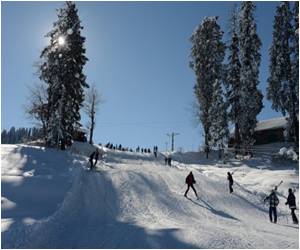In Indian Kashmir, every summer for two months, hundreds of thousands of devout Hindus, some chanting hymns, trek high into the Himalayas in a gruelling pilgrimage to a cave shrine.

By the end of the 55-day pilgrimage season, rubbish, including plastic bottles and bags, as well as human waste, can be found strewn across the mountain trails that wind through the fragile Himalayan environment.
Some of the rubbish falls into melted glaciers rushing through the valleys, threatening a vital source of drinking water for thousands of people who live downstream, experts said.
"There are more than 53 glaciers in that area," said Professor Shakil Ramshoo, who heads the earth sciences department at the University of Kashmir.
"Huge quantities of fecal matter and waste generated from the many eateries directly finds its way into the water bodies, deteriorating the water quality," he added.
The government and pilgrimage organisers insist they continuously improve measures to protect and preserve the environment. Sewage systems have been installed at the start of the mountain paths and a number of composting toilets have been set up -- on a trial basis -- along the way.
Advertisement
In 2008, the transfer of a parcel of land to shrine administrators, partly to build better facilities, sparked separatist claims of a Hindu takeover and triggered anti-India protests in the region. The transfer was later rescinded.
Advertisement
"(However) we are committed... The environment of the area is extremely important," said Choudhary, chief executive officer of the Shri Amarnath Shrine Board.
He added: "We have to preserve it while providing any facilities for the yatris (pilgrims)."
Pilgrims from across the globe visit the Amarnath shrine to view its remarkable natural ice formation, worshipped as a symbol of Shiva, the god of destruction. Hindus believe it was in the cave that Shiva revealed the secrets of life and immortality to his divine consort Parvati.
The sacred stalagmite appears each year in the cave -- although it often melts away before the annual pilgrimage ends.
"All difficulties and worries vanish by visiting this place. That is why everyone comes here," said Shopinder Achariya, a pilgrim from the Indian city of Lucknow who has trekked to the shrine every year since 2001.
"This place is special because here Lord Shiva narrated the eternal story to Mother Parvati," Achariya said.
Devotees come in large numbers even though the pilgrimage has been attacked in the past by Muslim rebels opposed to Indian rule of the region.
At least 32 pilgrims were killed in 2000 when militants attacked pilgrims. Ten more were killed the following year and there have been minor attacks since then.
More than 350,000 pilgrims hiked to the cave this season, which ended on August 21, down from a record number of 620,000 last year.
Rainy weather and a security clampdown following communal clashes were partially responsible for the drop in this year's visitors, officials said.
Despite the fall, environmentalists say a cap should be placed on the annual number of pilgrims and the season shortened to limit any environmental damage, said Arjimand Hussain Talib, a consultant on international development and conservation in the region.
"Any visits to Amarnath cave have to be strictly controlled as per the carrying capacity of the area," Talib said.
Some of the pilgrims, who can afford it, take a helicopter from the twin base camps in Sonmarg and Pahalgam -- two popular tourist destinations in the region.
But the chopper rides, along with the body heat of thousands of pilgrims, are adding to environmental concerns. Both are blamed for speeding up melting of the nearby glaciers in the ecologically sensitive area.
"On any given day during the pilgrimage about 30,000 people, emitting radiation at 37 degrees Celsius, are in the vicinity hastening the melting of these glaciers," Ramshoo said.
Many pilgrims also defecate in the open near the glacier-fed streams whilst temporary food shacks generate mounds more waste, he said.
Authorities say hundreds of temporary pre-fabricated toilets are set up every year all along the two tracks leading to the shrine, but only a few are bio-degradable ones, that can ensure waste does not reach the streams.
Frequent rains in the valleys also wash away some of the rubbish, making it difficult to collect for disposal, environmentalists say.
Pilgrimage administrators counter that the clean-up operation is extensive, lasting two months after the season ends.
"We see to it that all the garbage in the area is properly disposed off," Choudhary said.
Source-AFP









